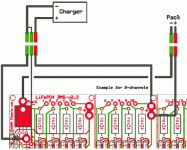Hi everybody,
I need help, I just finished the BMS 2.3 but I have a problem . I have already test the LVC (TC54VN), the 16th are ok. But when I plug the charger(no cells hook up), all the orange leds lit in a split second and then turn off. The main led is still green. The reference voltage on LM431 of the cells 5, 6, ….16 is 2.3V instead 2.5V, so LM431 are not trigged (the voltage is 3.7V on each unit cells except unit cells 1,2,3,4). The resistors of the voltage divided are well 75K and 180K.
On the unit cells 1, 2, 3, 4 the voltage is only 0.3V ! I don’t understand what’s happen. I check the space of each components. All seem well be placed.
The voltage charger is 61.5V.
I attach photos with the voltage measures.( It's not my board on the photo)
Is someone have an idea ?
Thank you in advance
Michael
[ATTACH type="full" alt="Voltage BMS Measure.jpg"]25229._xfImport[/ATTACH]
[ATTACH type="full" alt="Voltage BMS Measure 2.jpg"]25230._xfImport[/ATTACH]


